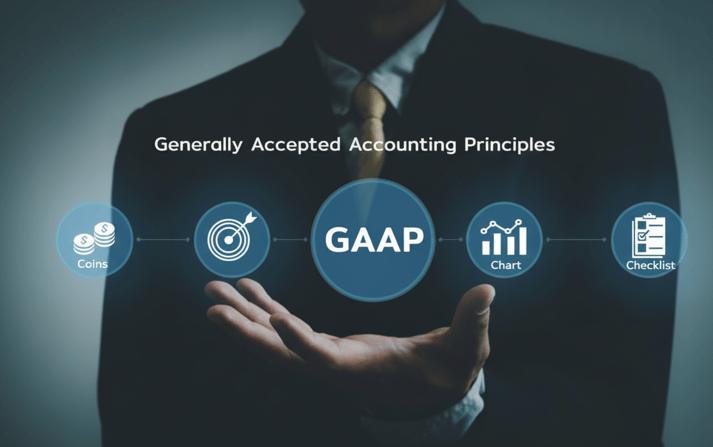A Checklist Of Things To Start A Business in 2024 Starting a business can be pretty challenging,...
GAAP vs. IFRS: What Every U.S. Founder Should Know Before Scaling

If you’re a U.S. founder preparing your company for growth, investment, or international expansion, you’ve likely heard the acronyms GAAP and IFRS. These two accounting frameworks define how financial statements are structured, how revenue is recognized, and how investors interpret your performance.
For manufacturing founders, the differences between GAAP and IFRS go beyond technical accounting—they directly impact compliance, valuation, and global credibility.
This guide simplifies the comparison between GAAP and IFRS, highlighting what every U.S. founder should understand before scaling into new markets.
Why Founders Should Care
Financial standards aren’t just about compliance—they shape how outsiders view your company’s strength. Lenders, investors, and regulators all rely on financial statements to judge your business health.
Whether you report under Generally Accepted Accounting Principles (GAAP) or International Financial Reporting Standards (IFRS) determines:
-
How you measure assets and liabilities
-
How you recognize revenue and expenses
-
How you present your balance sheet and income statement
If you plan to attract international investors or expand manufacturing abroad, understanding the shift from GAAP to IFRS can prevent misinterpretations, restatements, or lost funding opportunities.
For more on how financial reporting influences investor confidence, see importance of financial reporting for founder-owned manufacturing companies.
What Is GAAP?
GAAP (Generally Accepted Accounting Principles) is the U.S. accounting standard overseen by the Financial Accounting Standards Board (FASB). It provides detailed, rules-based guidelines for preparing and presenting financial statements.
GAAP emphasizes precision and compliance. Every number—whether it’s depreciation or revenue—follows specific procedures. This consistency ensures comparability across companies, which is vital for U.S. investors and regulators.
Most domestic manufacturers and service-based businesses adhere to GAAP when preparing financials for audits, loans, or tax purposes.
To understand how GAAP principles translate into real business reporting, explore what is GAAP and why it is needed.
What Is IFRS?
IFRS (International Financial Reporting Standards) is the global accounting framework used by more than 140 countries, including the U.K., Canada, and much of Europe. It’s principles-based, meaning it provides flexibility in how standards are applied.
Rather than prescribing exact methods, IFRS focuses on intent and transparency—allowing companies to represent their economic reality more fluidly.
This flexibility benefits multinational firms but requires stronger professional judgment to ensure consistent application.
If your manufacturing company plans to operate or attract investment outside the U.S., you’ll likely encounter IFRS-based requirements.
Key Differences Between GAAP and IFRS
While both aim to ensure accurate, reliable financial information, they differ in philosophy and execution. Here’s how those differences play out:
| Area | GAAP (U.S.) | IFRS (International) |
|---|---|---|
| Framework Type | Rules-based | Principles-based |
| Inventory Accounting | Allows LIFO, FIFO, Average Cost | Prohibits LIFO; allows FIFO and Average Cost |
| Revenue Recognition | Follows ASC 606 for specific criteria | Based on broader performance obligations |
| Development Costs | Expensed as incurred | Can be capitalized under certain conditions |
| Revaluation of Assets | Not allowed | Permitted for fixed assets and intangibles |
| Financial Statement Format | Structured with specific order and classifications | Allows flexibility in presentation |
| Extraordinary Items | Reported separately | Not reported separately |
These differences directly impact how manufacturing costs, inventory, and profitability are reported. For example, GAAP’s allowance of LIFO (Last In, First Out) can reduce taxable income when material costs rise—something IFRS doesn’t permit.
For manufacturers using LIFO inventory valuation, review FIFO vs. LIFO vs. Average Cost: Inventory Valuation Methods for Manufacturers.
How GAAP and IFRS Treat Revenue Recognition
Revenue recognition defines when income officially counts as “earned.”
Under GAAP, revenue is recognized through a five-step model:
-
Identify the contract
-
Identify performance obligations
-
Determine transaction price
-
Allocate price to obligations
-
Recognize revenue upon satisfaction
IFRS uses similar steps but allows more interpretation based on the nature of the contract.
This flexibility helps international companies adapt, but it can complicate comparisons between GAAP and IFRS financials—especially in industries like manufacturing, where long-term contracts are common.
Understanding how timing impacts your bottom line is crucial for forecasting; see financial modeling vs. forecasting for how these standards tie into projections.
The Impact on Financial Statements
1. Balance Sheet
Under IFRS, assets can be revalued upward if their fair value increases—giving a more optimistic view of net worth. GAAP forbids this, keeping asset values conservative.
If you’re managing equipment-heavy operations, this difference affects your capital planning and profitability analysis.
2. Income Statement
GAAP allows extraordinary items to appear separately; IFRS doesn’t. That means sudden one-time gains or losses (like selling a plant) blend into normal operations under IFRS.
3. Cash Flow Statement
Both frameworks classify cash flow similarly but differ in how interest and dividends are treated. Under IFRS, companies can choose whether to classify these as operating or financing activities. GAAP is stricter.
For guidance on interpreting cash flow reports under either framework, review a founder’s guide to cash flow management.
How These Differences Affect Manufacturing Businesses
Manufacturers often deal with long production cycles, significant capital investments, and fluctuating input costs. These conditions magnify accounting differences.
-
Inventory Accounting: GAAP’s LIFO option can reduce taxable income when material prices rise, but IFRS eliminates that advantage.
-
Asset Valuation: IFRS lets you revalue machinery to fair market value, which can improve balance sheet strength for lenders.
-
Lease Accounting: Both standards now recognize most leases on the balance sheet, but IFRS offers more flexibility in classification.
If you operate internationally, aligning reporting under both frameworks ensures transparency for investors and partners.
Why GAAP Still Dominates in the U.S.
Despite global trends toward IFRS, GAAP remains the required standard for U.S. companies. Public companies listed on U.S. exchanges must file under GAAP.
Private manufacturers, however, have more flexibility—especially if they seek global funding or partnerships. Some use dual reporting to prepare GAAP statements for U.S. tax compliance and IFRS versions for international stakeholders.
Transitioning Between GAAP and IFRS
Switching frameworks is a complex process that requires adjusting your accounting systems, retraining staff, and restating historical data.
Steps include:
-
Mapping Accounts – Match GAAP accounts to IFRS equivalents.
-
Restating Comparatives – Adjust prior-year financials to align with new policies.
-
Updating Reporting Systems – Adapt ERP and accounting tools for compliance.
-
Communicating with Stakeholders – Explain how changes affect ratios and performance metrics.
This process mirrors the system optimization discussed in how accounting automation improves manufacturing finance.
Key Considerations for U.S. Founders
-
Know Your Audience: If your investors are U.S.-based, GAAP suffices. If they’re global, consider IFRS alignment.
-
Evaluate Tax Impacts: LIFO advantages vanish under IFRS—understand the effect before switching.
-
Review Debt Agreements: Some loan covenants depend on GAAP metrics. Changing standards could affect compliance.
-
Invest in Financial Expertise: Consult CFOs or accounting firms familiar with both frameworks. Fractional CFOs can guide this transition cost-effectively.
The Future of GAAP vs. IFRS
The gap between GAAP and IFRS continues to narrow. Joint projects by FASB and IASB (the global standards board) aim to harmonize reporting standards.
While full convergence remains distant, U.S. founders should stay aware of global developments—especially if manufacturing or raising capital abroad.
Companies that adopt adaptable accounting systems today will face fewer challenges tomorrow.
Practical Example
A U.S. industrial equipment manufacturer began courting European investors. Their GAAP statements showed stable earnings, but the investors requested IFRS-compliant reports.
After revaluing assets under IFRS, the company’s equity position improved by 9%. That adjustment helped secure a funding round worth $15 million.
The takeaway? Understanding both standards doesn’t just ensure compliance—it can open doors to global growth.
The Bottom Line
GAAP and IFRS share the same goal—clear, consistent financial reporting—but differ in execution.
-
GAAP ensures detailed, rule-based accuracy for U.S. compliance.
-
IFRS offers flexibility and transparency for global investors.
As a founder, knowing the difference helps you choose the right framework for your strategy, whether it’s domestic stability or international expansion.
Your numbers tell your story—make sure they’re written in the language your stakeholders understand.
Thinking about expanding internationally or raising global investment?
Contact Accounovation to align your financial reporting with GAAP and IFRS standards—so your numbers are ready for growth, wherever it leads.







